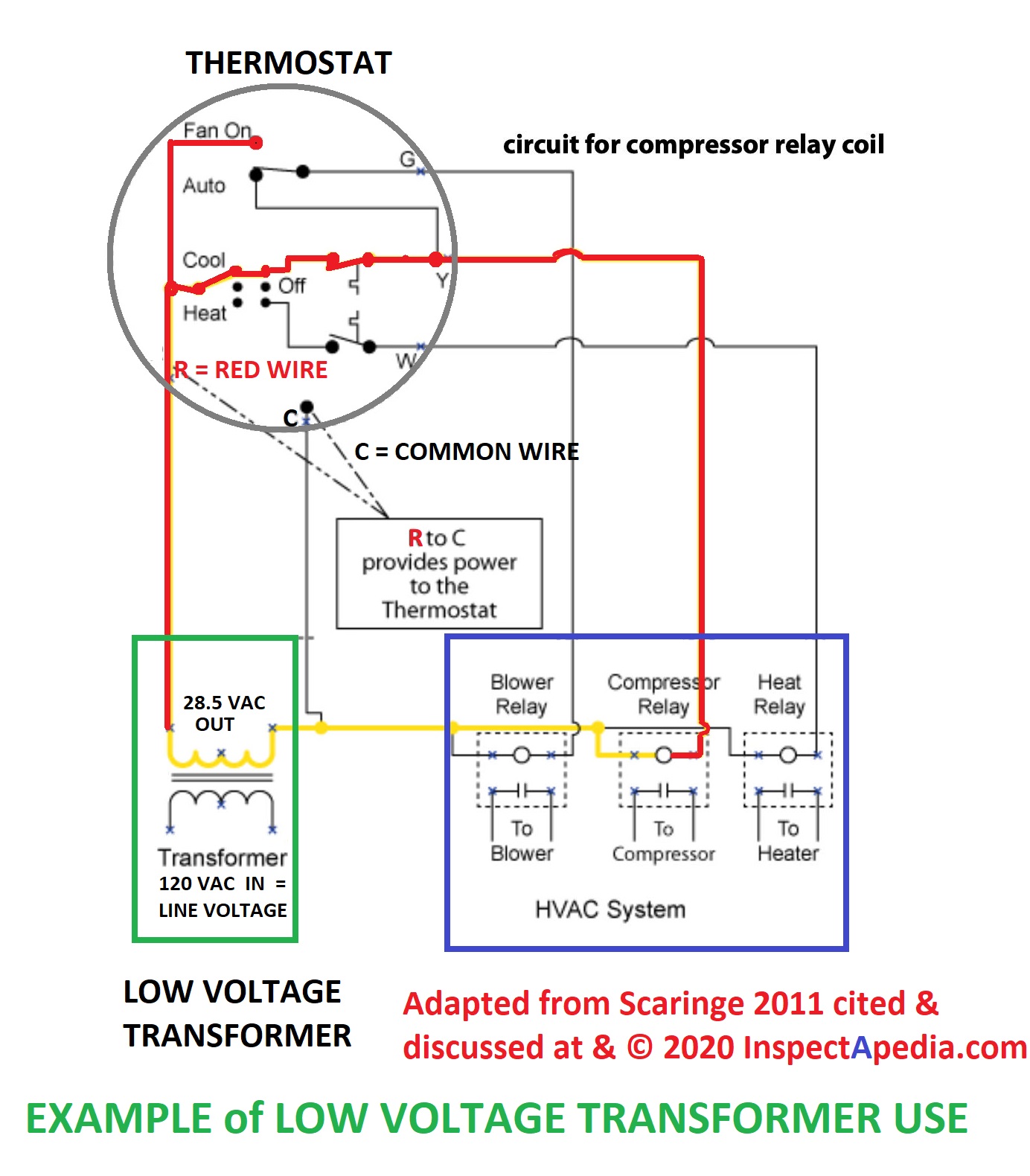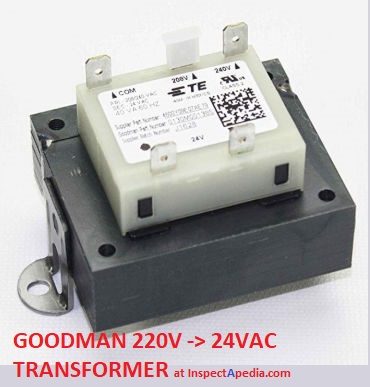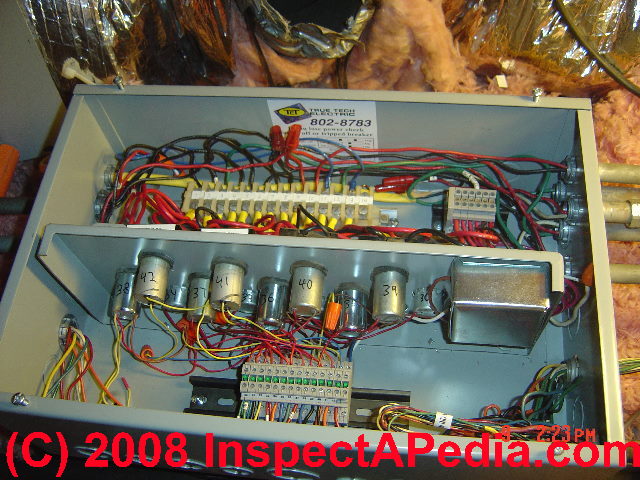 Low Voltage Transformer Transverter Converter
Low Voltage Transformer Transverter Converter
Install, troubleshoot, repair, replace LV transformers, converters, transverters
- POST a QUESTION or COMMENT about low-voltage wiring, relays, switches, transformers, transverters & devices
How to install, diagnose, and repair of low voltage transformers, transverters & converters used to power low voltage lighting systems, control systems & HVAC Equipment.
Page top photo: A control panel of GE Low Voltage relays after re-wiring repairs.
This article series discusses low voltage electrical wiring repair, parts substitution, parts replacement, and repair warnings.
We describe the properties of low-voltage-controlled switches that operate 120V lights and receptacles in homes dating from the 1960's to the present.
InspectAPedia tolerates no conflicts of interest. We have no relationship with advertisers, products, or services discussed at this website.
- Daniel Friedman, Publisher/Editor/Author - See WHO ARE WE?
Guide to Low Voltage Building Wiring Transformers or Transverters
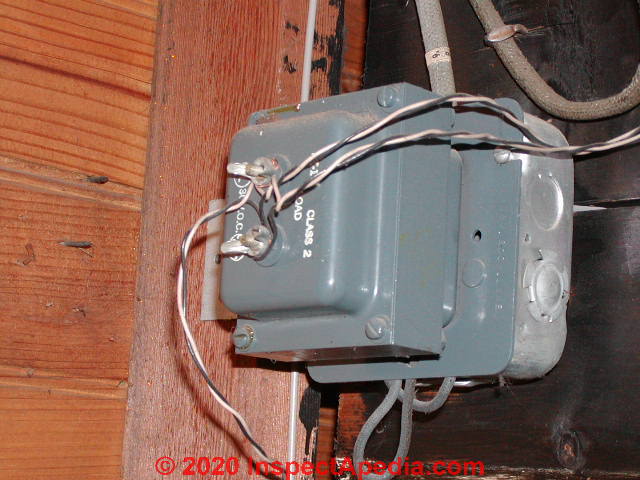 Photo: a low voltage transformer taking 120VAC input voltage and providing 24VAC output voltage commonly used to control heating or air conditioning thermostats or to supply low-voltage lighting relays in a building. - photo courtesy of professional home inspector David Goldstein cited at REVIEWERS
Photo: a low voltage transformer taking 120VAC input voltage and providing 24VAC output voltage commonly used to control heating or air conditioning thermostats or to supply low-voltage lighting relays in a building. - photo courtesy of professional home inspector David Goldstein cited at REVIEWERS
An electrical "transformer" converts voltage from one level to another, say from 120 Volts down to 28 Volts or to 24-Volts in order to supply the lower voltage to devices that are designed to operate at that level. A "converter" changes alternating current to direct current.
Electrical power entering buildings in the U.S. and in most of the world operates at 60-cycle alternating current (or 50 cycle AC).
Watch out: while low-voltage electrical wiring, typically in the 24VAC-28.5VAC range is safe and presents no risk of electric shock injury, the low voltage transformer or transverter is supplied with 120VAC or 220VAC as are line-voltage devices in most buildings.
If you are not trained in proper and safe electrical wiring you could cause a building fire or could be shocked or killed working on or installing a low voltage transformer.
In addition even low-voltage wiring, if improperly-installed, may make the equipment it is intended to operate unsafe.
Alternating current:
If you measured the voltage level on an AC circuit, you'd see the voltage level varying between +120V down through 0 volts and continuing down to -120V and then cycling back up again 60 times a second. That's what 60-cycle AC means.
Direct current:
if you measure the voltage level on a DC circuit, you'll see the level staying roughly constant at whatever voltage level the circuit is supplying. For example, most automobiles operate most of their electrical components at 12-volts direct current or 12-V DC.
The switches and the relays they control in a building low-voltage wiring system are designed to operate at 28-volts of direct current.
Definition: An electrical "transformer" converts voltage from one level to another, say from 120Volts down to 28Volts in order to supply the lower voltage to devices that are designed to operate at that level.
Definition: A current "converter" changes alternating current to direct current. Electrical power entering buildings in the U.S. and in most of the world operates at 60-cycle alternating current (or 50 cycle AC).
What's the difference between a "transformer" and a "transverter"? Not much.
Definition: A "transverter" combines transformi g 120VAC or 220VAC to 24VAC or some other low voltage, combined with changing alternating current to direct current.
For example, a 120 VAC input to the transferter may produce 28V DC output current.
So in building low-voltage wiring systems a "transverter" is used to transform 120V down to 28V and also to convert the voltage from alternating to direct current.
We only need one of these transverters. Old low-voltage wiring electrical systems use a single transverter to accept incoming 120V AC current and change it to 28V direct current.
The switching relays in older low-voltage wiring systems are operated individually, that is, one at a time.
For example, most automobiles operate most of their electrical components at 12-volts direct current or 12-V DC. The switches and the relays they control in a building low-voltage wiring system are designed to operate at 28-volts of direct current.
The switching relays in older low-voltage wiring systems are operated individually, that is, one at a time.
In a building using low voltage switches to operate lights, the transformer is supplied with 120VAC or in some countries 220 or 240 VAC or even 277 VAC as input voltage and it provides 24VAC output voltage that is sent through low-voltage wiring to power control relaysthat in turn are controlled by low voltage switches or other controls.
The transverter is step-down transformer which is itself powered by a 120V circuit in the building converts its incoming 120-volt alternating current (120 VAC) to a 28-volt direct current (28 VDC).
This is the operating voltage and current type used to power the switches and the relays that they turn on and off.
Diagnose, Repair or Replace Low Voltage Wiring Transformer or Transverter
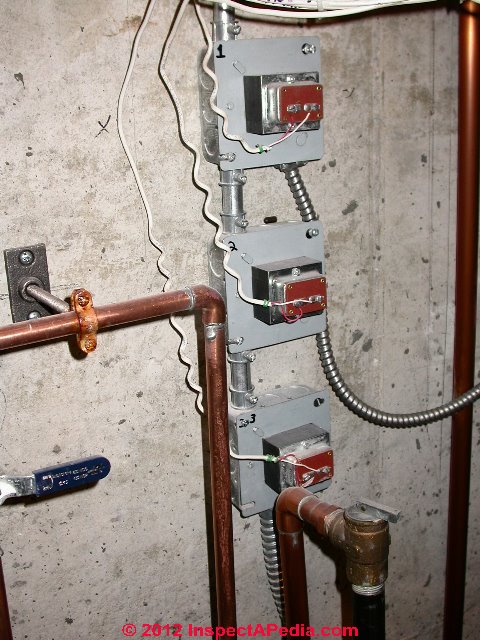 Intermittent Failure of Lights or other Relay-controlled Devices
Intermittent Failure of Lights or other Relay-controlled Devices
Intermittent operation of lights or other relay-controlled devices in a home usually is due to a failing power supply transverter. The voltage output of the Transverter should be 28 - 31 VDC. If voltage is not in that range, the transverter should be replaced.
Low Voltage Output at the Transverter
Low voltage at a transformer/transverter may mean that it needs to be replaced, or it may simply mean that a switch in the home is stuck.
Check the Transverter voltage output. In a normal low-voltage electrical system the output voltage at the transverter should be 28 - 30 VDC if measured between the "switch" and the "relay" output wires on the Transverter with either one of these wires disconnected.
You don't need to disconnect both wires since disconnecting just one of them interrupts the circuit. But of course it's ok to disconnect both.
If the voltage is 0 VDC, or a really low 2 - 4 VDC, this is indicates of a stuck low-voltage switch. Touch-Plate Lighting informs us that the transverter drops in voltage output down to 3 volts after operating the relay coil in order to protect against burning up the coil.
If you read a voltage higher than 3 volts and lower than 26 VDC from the Transverter, then the transverter should be replaced.
If you are reading 28 - 30 VDC and still nothing is working then you have a wiring problem:
something is not connected (as in a wire coming loose from under a wire nut) or something incorrectly wired (as in when changing a component in the system and not re-connecting to the proper wire).
See
Basics of Wiring Low Voltage Transformers
Shown here, a Honeywell 24VAC low voltage transformer marked NEMA type D, meets NEC class 2 not wet, class 3 web UL 1585 requirements.
The low-voltage wire screw terminals on the face of the transformer are marked "LOAD" and "C" or "Common"
For clarity we have over-written the text embossed in the tan plastic face of this transformer the letters R, Load, and C (for Common) using Red and Black in the another photo of the face of this transformer, given just below.
The high voltage wire connections to the transformer are made by using the black and white leads provided.
Standard line voltage wiring connections at the transformer - the "Primary" side
- Black Line-voltage Hot 120VAC wire: connected to the black transformer 120VAC lead - shown in photo above on this page
- White Line-voltage Neutral wire 120VAC: connected to the white transformer 120VAC lead - shown in photo above on this page
[Click to enlarge any image]
In typical HVACR control circuits and in building low-voltage lighting control systems, the low voltage transformer has AC input voltage and produces AC outpout voltage (typically at 24VAC or at 28.5 VAC though other output voltages are available
For equipment that needs a DC (Direct Current) electrical supply, other versions of these transformers can be fed 120VAC (or 220VAC) and can include an intrnal diode that will produce DC outpout on the secondary side.
Standard low-voltage wire connections at the transformer - the G99dja"Secondary" side
- Red low voltage wire 24 or 28.5 VAC : usually wired to the R or power terminal - found on the transformer face, exposed
- Black low voltage wire 24 or 28.5 VAC: usually wired to the C or common terminal - found on the transformer face, exposed
Other Low-Voltage (LB) Transformer, LV Device, LV WiringConnections
- At low voltage lighting or control relays, the Black wire and the Red wire are the On and Off lines between the low-voltage switch and the relay.
- At HVAC thermostats the R or Red wire from the low voltage transformer is usually bringing 24VAC to the thermostat and is wired in the thermostat to the R terminal. ).
Details about thermostat wiring and low voltage control wiring for tranformers used on heating and air conditioning circuits are found
at THERMOSTAT WIRE CONNECTIONS
In low voltage lighting control systems, unlike a conventional 120-V electrical light circuit switch, the low voltage switch is talking not to the light, but to the relay. The low-voltage relay is also referred to as a "latching relay".
A "latching relay" is a switch that "latches" into whatever position it is told to enter.
So such a relay needs to receive a separate signal to tell to it to "Make" (turn on) or "Break" (turn off) the household current which the relay is passing on to the light or other device it controls.
If an older low voltage transverter still has the labels by the output wires, you may see labels reading "switch" and "relay". When wiring such a transverter, connect the wire from your low-voltage switch to the terminal marked "Switch".
Similarly, connect the wire from the relay to the transverter terminal marked "Relay".
If the older Transverter connections are not labeled we're in more trouble but it's still simple to determine which wire to connect to which terminal.
Watch out: Before disconnecting the old transverter, follow the wires from the old Transverter to what it is connected to. Touch-Plate Lighting says the easiest way to do this is by locating the wire of the Transverter that connects to one wire of every relay inside the relay enclosure.
This wire will be the "relay" wire. Therefore the other wire will be the "switch" wire.
Our illustration above, adapted from Scaringe (2011) illustrates the use of a 28.5 VAC low voltage transformer to power, through a room thermostat, relays controlling an HVAC system.
How to Choose the Right Transformer for Home Low Voltage Wiring Systems
Touch-Plate's TPS-0120 120V Transverter power supply operates relays from every Touch-Plate® system from 1946 to early 1980’s. It's input is 120 V A. C.
Its output: 28.5V D.C.
Other power supplies are used to transform 120V to 6.3 V A. C. offering from .150A (150 milliamps) up to 4 Amps (400 mva) depending on the application such as for pilot lights (incandescent lamps explained just above), or other power supplies.
Other power supplies may be found installed for for pilot lights.
These are simply little lights at switches that indicate if the device controlled by the switch has been turned "on" or "off". If you see a silver box labeled "PL-6" mounted above or below each relay this is a transformer for pilot lights.
Touch-Plate Lighting says that the the pilot light transformers for the master switch stations are usually located in the master bedroom and/or some other main living area.
Touch-Plate also points out that these transformers are not necessary to operate electrical lights or receptacles in the building. If the pilot lights were to malfunction or stop working, you would lose the indicator light for the specific relay it is connected to, nothing more.
That is, a PL-6 power supply has nothing to do with operating the relay itself, only the indicator light that shows if a relay (and the device it controls) is switched "on" or "off".
Low Voltage Transformer Wiring Instructions, Manuals
Photo: a Goodman 208/240VAC to 24VAC transformer as sold online, P/N Goodman 0130M00138S
- ANSI/IEEE C57.94-2002 (Recommended Practice for Installation, Application, Operation and Maintenance of Dry-Type General Purpose Distribution and Power Transformers)
- Focus Ind, TRANSFORMERS & CONTROLS MANUAL [PDF] (2011) RXT Series, Focus Industries, 25301 Commercentre Drive Lake Forest, CA 92630 USA www.focusindustries.com Email: info@focusindustries.com Tel: (888) 882-1350
- Moonrays, OUTDOOR LOW VOLTAGE TRANSFORMER INSTALLATION & USE [PDF] for 12-Volt Lighting Systems, MODEL NO: #95432 200 Watts Maximum (PTST-20012) MODEL NO: #95433 300 Watts Maximum (PTST-30012) MODEL NO: #95436 600 Watts Maximum (PTST-60012) - Contact Moonrays; Tel: 1-800-561-4321
- Pegasus Lighting, "Low Voltage Transformers FAQs", Pegasus Lighting is a supplier of lighting fixtures, bulbs, power supplies and controls. Tel: Website: www.pegasuslighting.com, - retrieved 11/23/2014, original source: http://www.pegasuslighting.com/low-voltage-transformers.html
Quoting
The output of an electronic low voltage transformer, unless it is a DC low voltage transformer, is high frequency (20,000-50,000 Hertz). This means that there can be a substantial voltage drop if the wires carrying the high-frequency current are long, thin, or far apart.
Always follow these rules to avoid a large voltage drop. Use thick wires on the secondary/output side. The thicker the wire, the less the voltage drop you will experience.
The shorter the distance between transformer and lamp(s), the less the voltage drop you will experience. Try to use a pair of secondary wires that are twisted together.
The closer the two output wires are to each other, the lower the voltage drop you will experience. When a low voltage transformer powers more than one fixture or circuit, split the output of the low voltage transformer immediately into several separate circuits rather than carrying all the power in one pair of wires.
The less power per circuit, the less the voltage drop you will experience. That is, a circuit with a total of 300 watts of load will have a greater voltage drop than a circuit with only 50 watts of load. A DC low voltage transformer offers the only electronic solution that overcomes this type of voltage drop issue. - PowerSmiths LOW VOLTAGE TRANSFORMER INSTALLATION, OPERATION, MAINTENANCE MANUAL [PDF] Powersmiths International Corp.
10 Devon Rd.
Brampton, ON. L6T 5B5
Phone: 905 791 1493
Fax: 905 791 5159
Toll Free: 1 800 747 9627
support@powersmiths.com retrieved 2020/02/01 original source: https://www.powersmiths.com/wp-content/uploads/2016/04/Install-Op.-Maint.-Manual-Transformers-806.1800.600.A09.pdf
Excerpt:
These guidelines are provided as a guide to assist in the installation of the transformer but for more indebt installation refer to ANSI/IEEE C57.94-2002 (Recommended Practice for Installation, Application, Operation and Maintenance of Dry-Type General Purpose Distribution and Power Transformers) and for Electrical Codes: National Electric Code (NEC) for USA; Canadian Electric Code (C22.1) for Canada - [14] Bob Scaringe, Ph.D., P.E., THERMOSTATIC WIRING PRINCIPLES [PDF] QwikProducts by Mainstream Engineering, Rockledge FL, Tel: 800-866-3550, Website: http://www.mainstream-engr.com/, retrieved 7/17/2011, original source http://www.epatest.com/store/resources/images/misc/how-a-thermostat-operates.pdf,
- Universal Forest Products LOW VOLTAGE LIGHTING POWER SUPPLY [PDF] (2012), Universal Forest Products, Inc., for outdoor lighting, versionsproviding 120W 12VAC or 45W 12VAC
- Volt® LOW VOLTAGE TRANSFORMER INSTALLATION GUIDE [PDF] Models 75W, 150W, 300W, 600W, 900W, 1200W, 15486 N. Nebraska Avenue | Lutz, FL 33549 | 1.813.978.3700 www.voltlighting.com
- [15] Voltage Transformer, U.S. Patent No. 2,412,345, Dec. 10, 1946, Nils E. Lindenblad, Port Jefferson, NY, for Radio Corporation of America
...
Continue reading at LOW VOLTAGE TRANSFORMER TEST , or select a topic from the closely-related articles below, or see the complete ARTICLE INDEX.
Or see these
Recommended Articles
- BOILER CONTROLS & SWITCHES
- FURNACE CONTROLS & SWITCHES
- HEAT WON'T TURN OFF
- HEAT WON'T TURN ON
- LOW VOLTAGE BUILDING WIRING - home
- COMMON WIRE at THERMOSTATS
- LOW VOLTAGE WIRING SYSTEM COMPONENTS
- LOW VOLTAGE LIGHTING & CONTROL RELAYS
- LOW VOLTAGE TRANSFORMERS, TRANSVERTERS, CONVERTERS
- LOW VOLTAGE TRANSFORMER, TRANSVERTER DIAGNOSIS
- LOW VOLTAGE TRANSFORMER TEST
- LOW VOLTAGE TRANSFORMER WIRING GUIDE
- LOW VOLTAGE WIRING REPAIR or UPGRADE
- LOW VOLTAGE WIRING REPAIR PARTS SOURCES
- THERMOSTAT WIRE CONNECTIONS
- THERMOSTAT WON'T TURN OFF
- THERMOSTAT WON'T TURN ON
- VOLTS MEASUREMENT METHODS
- ZONE DAMPERS
- ZONE VALVES, HEATING
Suggested citation for this web page
LOW VOLTAGE TRANSFORMERS, TRANSVERTERS, CONVERTERS at InspectApedia.com - online encyclopedia of building & environmental inspection, testing, diagnosis, repair, & problem prevention advice.
Or see this
INDEX to RELATED ARTICLES: ARTICLE INDEX to ELECTRICAL INSPECTION & TESTING
Or use the SEARCH BOX found below to Ask a Question or Search InspectApedia
Ask a Question or Search InspectApedia
Questions & answers or comments about low-voltage wiring, relays, switches, transformers, transverters & devices.
Try the search box just below, or if you prefer, post a question or comment in the Comments box below and we will respond promptly.
Search the InspectApedia website
Note: appearance of your Comment below may be delayed: if your comment contains an image, photograph, web link, or text that looks to the software as if it might be a web link, your posting will appear after it has been approved by a moderator. Apologies for the delay.
Only one image can be added per comment but you can post as many comments, and therefore images, as you like.
You will not receive a notification when a response to your question has been posted.
Please bookmark this page to make it easy for you to check back for our response.
IF above you see "Comment Form is loading comments..." then COMMENT BOX - countable.ca / bawkbox.com IS NOT WORKING.
In any case you are welcome to send an email directly to us at InspectApedia.com at editor@inspectApedia.com
We'll reply to you directly. Please help us help you by noting, in your email, the URL of the InspectApedia page where you wanted to comment.
Citations & References
In addition to any citations in the article above, a full list is available on request.
- David Goldstein - contributor and technical review. Mr. Goldstein is a principal of Ambic Home Inspection in Downingtown, PA 19335 610-269-7365
- Touchplate Corporation: Diagnosing Low Voltage Wiring System Problems See http://www.touchplate.com/standardSupport.php
- In addition to citations & references found in this article, see the research citations given at the end of the related articles found at our suggested
CONTINUE READING or RECOMMENDED ARTICLES.
- Carson, Dunlop & Associates Ltd., 120 Carlton Street Suite 407, Toronto ON M5A 4K2. Tel: (416) 964-9415 1-800-268-7070 Email: info@carsondunlop.com. Alan Carson is a past president of ASHI, the American Society of Home Inspectors.
Thanks to Alan Carson and Bob Dunlop, for permission for InspectAPedia to use text excerpts from The HOME REFERENCE BOOK - the Encyclopedia of Homes and to use illustrations from The ILLUSTRATED HOME .
Carson Dunlop Associates provides extensive home inspection education and report writing material. In gratitude we provide links to tsome Carson Dunlop Associates products and services.




